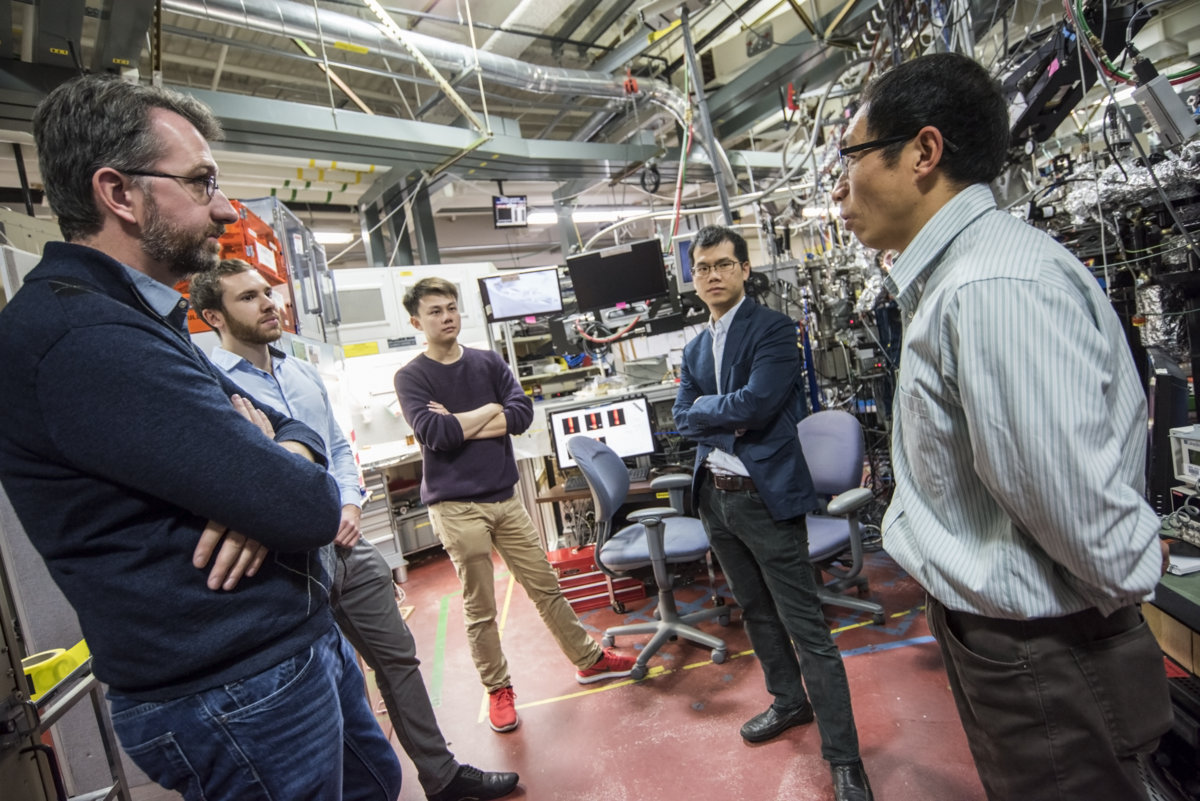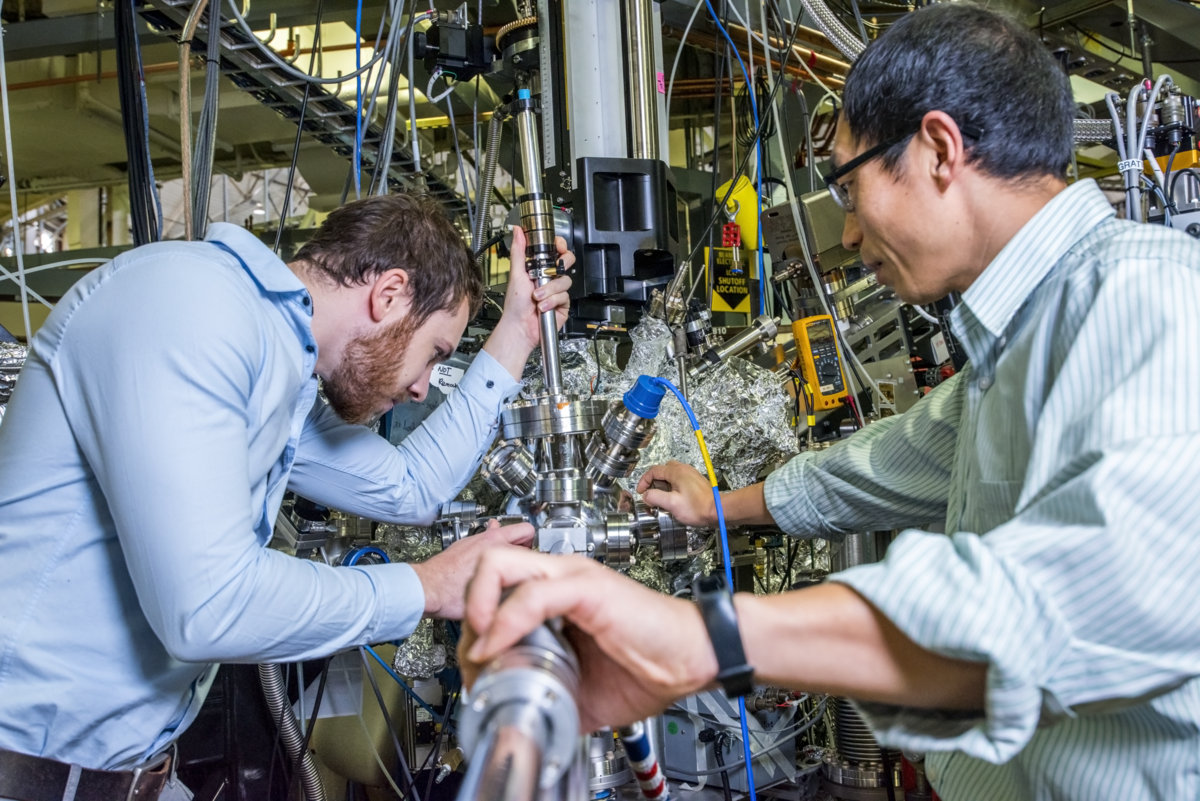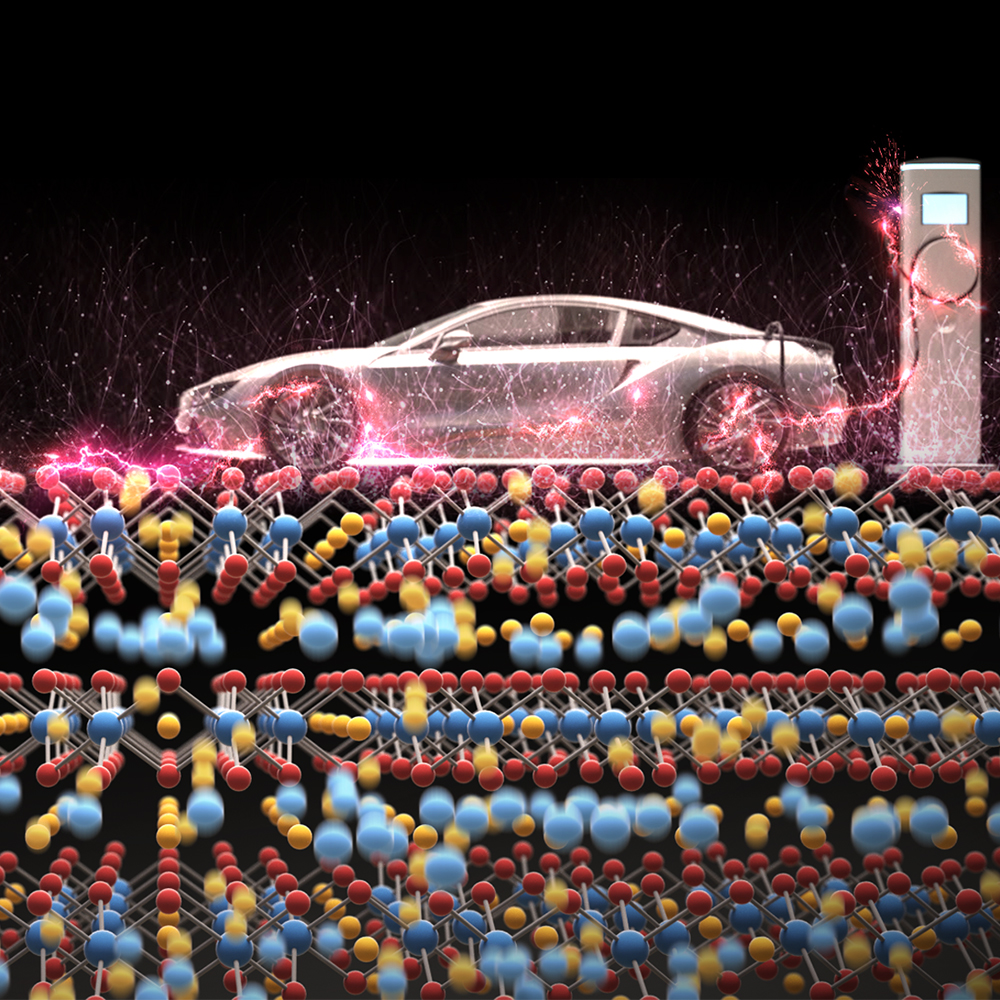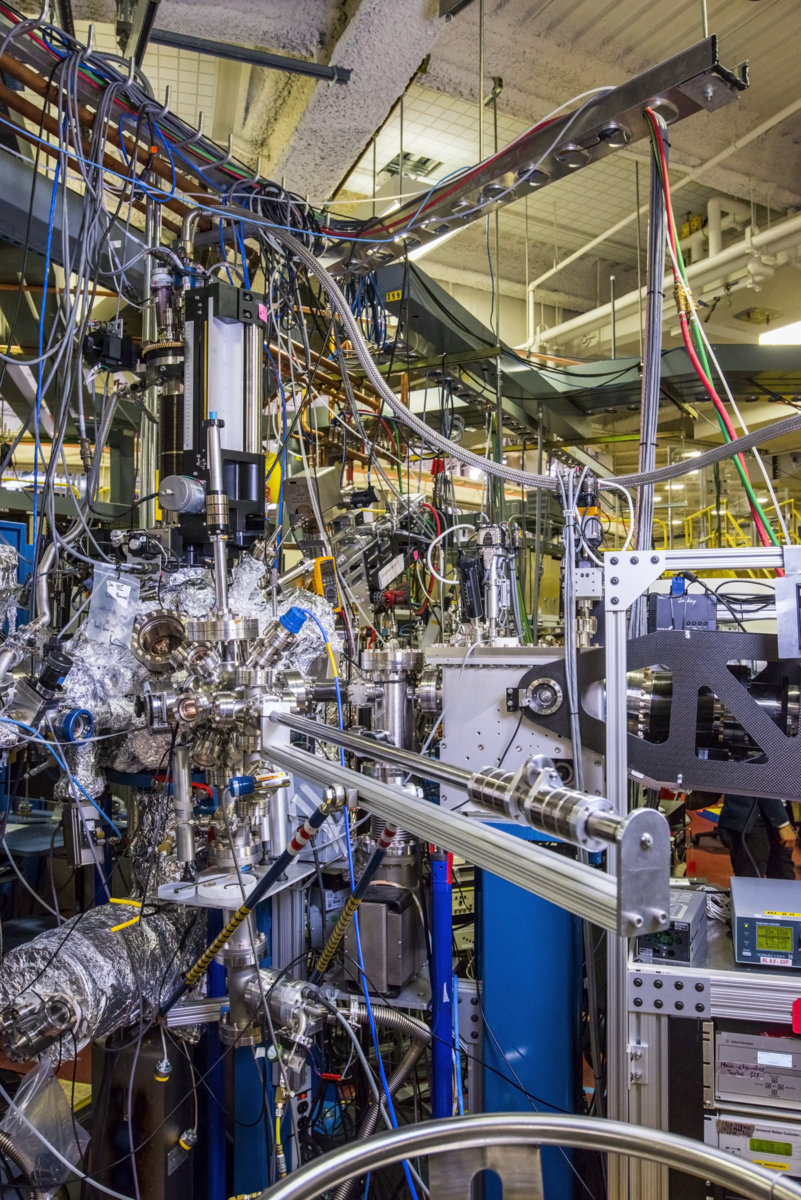Note: This press release is adapted from the original release by SLAC National Accelerator Laboratory. View the original release.
–By Glennda Chui/SLAC
This animation shows what happens when extra lithium ions are added to the positive electrode – the one on the right here — of a lithium-ion battery. In a regular lithium-ion battery, lithium ions move from the positive to the negative electrode during charging, and then back to their original positions when the battery is discharging, or doing work. The structure of the positive electrode –represented by the horizontal black lines –- does not change. In lithium-rich electrodes, extra lithium ions are added to layers of the positive electrode where they don’t normally appear. When they leave and return during battery operation, the structure of the electrode changes, as shown by the broken black lines, and the battery’s voltage fades. (Farrin Abbott/SLAC National Accelerator Laboratory)
If you add more lithium to the positive electrode of a lithium-ion battery – overstuff it, in a sense – it can store much more charge in the same amount of space, theoretically powering an electric car 30 to 50 percent farther between charges. But these lithium-rich cathodes quickly lose voltage, and years of research have not been able to pin down why – until now.
After looking at the problem from many angles, a research team including scientists from the Department of Energy’s Lawrence Berkeley National Laboratory (Berkeley Lab) created a comprehensive picture of how the same chemical processes that give these cathodes their high capacity are also linked to changes in atomic structure that sap performance. The team also includes researchers from SLAC National Accelerator Laboratory (SLAC), Stanford University, and battery manufacturer Samsung.
“This is good news,” said William E. Gent, a Berkeley Lab-affiliated researcher, Stanford University graduate student, and Siebel Scholar who led the study. “It gives us a promising new pathway for optimizing the voltage performance of lithium-rich cathodes by controlling the way their atomic structure evolves as a battery charges and discharges.”

From left to right: David Prendergast, Will Gent, Yufeng Liang, Will Chueh, and Wanli Yang, who participated in the battery electrode study, meet at Berkeley Lab’s Advanced Light Source. (Credit: Marilyn Chung/Berkeley Lab)
Michael Toney, a distinguished staff scientist at SLAC and co-author of the paper, added, “It is a huge deal if you can get these lithium-rich electrodes to work because they would be one of the enablers for electric cars with a much longer range. There is enormous interest in the automotive community in developing ways to implement these, and understanding what the technological barriers are may help us solve the problems that are holding them back.”
The team’s report appears today in Nature Communications.
The researchers studied the cathodes with a variety of X-ray techniques at Berkeley Lab’s Advanced Light Source (ALS) and at SLAC’s Stanford Synchrotron Radiation Lightsource (SSRL). Theorists from Berkeley Lab’s Molecular Foundry, led by David Prendergast, were also involved, helping the experimenters understand what to look for and explain their results.
At the ALS, researchers employed an advanced form of a technique known as soft X-ray resonant inelastic X-ray scattering – or iRIXS. It provided a higher-sensitivity probe of the material’s internal oxygen chemistry, which was difficult to detect through other techniques. The new system, which began operation at the ALS last year, scans samples much faster than before.
“RIXS has mostly been used for fundamental physics,” ALS scientist Wanli Yang said. “But with this new ALS system, we wanted to really open up RIXS for practical materials studies, including energy-related materials.”

Will Gent, left, and Wanli Yang work on instruments at the iRIXS endstation, part of Berkeley Lab’s Advanced Light Source. The endstation was key in a battery cathode study. (Credit: Marilyn Chung/Berkeley Lab)
Scientists also used another technique at the ALS based on soft X-ray microscopy, which allows you to distinguish a sample’s surface and internal chemistry. At SLAC’s SSRL, Toney and his colleagues used hard X-rays to make a careful determination of how the cathode’s atomic and chemical structure changed as the battery charged and discharged.
The cathodes themselves were made by Samsung Advanced Institute of Technology using commercially relevant processes, and assembled into batteries similar to those in electric vehicles.
“This ensured that our results represented an understanding of a cutting-edge material that would be directly relevant for our industry partners,” Gent said. As an ALS doctoral fellow in residence, he was involved in both the experiments and the theoretical modeling for the study.
Like a bucket half empty
Batteries convert electrical energy to chemical energy for storage. They have three basic parts – two electrodes, the cathode and the anode, and the liquid electrolyte between them. As a lithium-ion battery charges and discharges, lithium ions shuttle back and forth between the two electrodes, where they insert themselves into the electrode materials.
The more ions an electrode can absorb and release in relation to its size and weight – a factor known as capacity – the more energy it can store, and the smaller and lighter a battery can be, allowing batteries to shrink and electric cars to travel more miles between charges.
“The cathode in today’s lithium-ion batteries operates at only about half of its theoretical capacity, which means it should be able to last twice as long per charge,” said Stanford professor William Chueh, an investigator with the Stanford Institute for Materials and Energy Sciences (SIMES) at SLAC.
“But you can’t charge it all the way full. It’s like a bucket you fill with water, but then you can only pour half of the water out.”

Electric car makers are intensely interested in lithium-rich battery cathodes that could significantly increase driving range. A new study opens a path to making them live up to their promise. (Stanford University/3Dgraphic)
Like today’s cathodes, lithium-rich cathodes are made of layers of lithium sandwiched between layers of transition metal oxides – elements like nickel, manganese, or cobalt combined with oxygen. Adding lithium to the oxide layer increases the cathode’s capacity by 30 to 50 percent.
Prendergast of Berkeley Lab noted that removing all of this lithium can make the material unstable, though. “It’s like taking all of the bricks out of a building – there’s not a lot to hold it up,” he said.
“As you discharge it and charge it, you never get that capacity back again,” he added. “Understanding this effect is very important to pushing that technology forward. The material has such promise. We know it has high capacity.”
Prendergast’s work at the Molecular Foundry focused on supporting Gent’s efforts in developing atomic-scale structural models to explain what was observed in the X-ray experiments.
“There was a weird reordering of what elements are involved in the battery’s function,” he said. “It’s like the ground has shifted under your feet. This was a big puzzle.”
Connecting the dots
Previous research had shown that several things happen simultaneously when lithium-rich cathodes charge, Chueh said: Lithium ions move out of the cathode into the anode. Some transition metal atoms move in to take their place. Meanwhile, oxygen atoms release some of their electrons, establishing the electrical current and voltage for charging, according to Chueh. When the lithium ions and electrons return to the cathode during discharge, most of the transition metal interlopers return to their original spots, but not all of them and not right away. With each cycle, this back and forth changes the cathode’s atomic structure. It’s as if the bucket morphs into a smaller and slightly different bucket, Chueh added.
“We knew all these phenomena were probably related, but not how,” he said. “Now this suite of experiments at SSRL and the ALS shows the mechanism that connects them and how to control it. This is a significant technological discovery that people have not holistically understood.”
The team is already working toward using the fundamental knowledge they have gained to design battery materials that can reach their theoretical capacity and not lose voltage over time.
Prendergast noted that one aim in ongoing R&D will be to find ways to stabilize the framework for the lithium by preventing wandering atoms from getting stuck and obstructing flow during charge and discharge.
The combined microscopy and RIXS results in this study demonstrated the unique RIXS capabilities for energy materials research. Yang said he looks forward to more studies of this and related materials. “We could easily extend RIXS to other battery materials and reveal information that was not accessible before,” he said.
The Advanced Light Source, Molecular Foundry, and Stanford Synchrotron Radiation Lightsource are all DOE Office of Science User Facilities.
The research was funded by the DOE Office of Energy Efficiency and Renewable Energy’s Vehicle Technologies Office and by Samsung Advanced Institute of Technology Global Research Outreach Program.
View the original SLAC National Accelerator press release here.
###
Lawrence Berkeley National Laboratory addresses the world’s most urgent scientific challenges by advancing sustainable energy, protecting human health, creating new materials, and revealing the origin and fate of the universe. Founded in 1931, Berkeley Lab’s scientific expertise has been recognized with 13 Nobel Prizes. The University of California manages Berkeley Lab for the U.S. Department of Energy’s Office of Science. For more, visit www.lbl.gov.
SLAC is a multi-program laboratory exploring frontier questions in photon science, astrophysics, particle physics and accelerator research. Located in Menlo Park, California, SLAC is operated by Stanford University for the U.S. Department of Energy Office of Science. To learn more, please visit www.slac.stanford.edu.
DOE’s Office of Science is the single largest supporter of basic research in the physical sciences in the United States, and is working to address some of the most pressing challenges of our time. For more information, please visit science.energy.gov.
